What Is a Product Roadmap in Agile? Guide (2026)
Discover how product roadmaps work within agile frameworks, focusing on flexibility, prioritization, and stakeholder communication.

Many agile teams skip product roadmaps because they worry that a long‑term plan will tie them down. I used to think the same. Then I saw small teams flounder when short sprints had no bigger picture. A roadmap done well doesn’t mean locking yourself into an inflexible schedule; it means giving your team context and shared intent. In the next sections, I’ll answer what is a product roadmap in agile by breaking down its purpose, components and practical tips. You’ll learn when to build one, how to keep it adaptable, and why it’s worth the effort.
TL;DR:
An Agile product roadmap is a flexible, strategic plan that aligns a product's long-term vision with short-term execution. Unlike rigid project plans, it emphasizes outcomes over outputs and adapts to change, helping teams stay focused on goals while remaining responsive. It typically includes themes, initiatives, and time horizons (like Now/Next/Later), serving as a communication tool between teams and stakeholders. A well-crafted roadmap provides clarity, direction, and context without micromanaging work—bridging strategy and day-to-day decisions in fast-paced environments.
What a product roadmap is and why it matters?
A product roadmap is a shared, big‑picture plan that shows how a product may change over time and why. It sits above the backlog, giving context and direction. Monday.com describes it as a broad action plan that outlines the steps to achieve your long‑term vision. Atlassian’s agile coach adds that it should give teams context for their day‑to‑day work. Unlike a backlog filled with tasks and dates, the roadmap focuses on outcomes, themes and sequence, and it must adjust as new information emerges.
A good roadmap helps agile teams connect sprint‑scale decisions to long‑term strategy. It also communicates intent to stakeholders and reduces surprises: the Mural team calls it a single source of truth. Tempo’s research shows that a clear roadmap bridges long‑term goals and short‑term actions, while ProductPlan’s survey found that most product professionals value roadmapping features. Even flexible teams need structure to avoid chaos.
Core components of an agile product roadmap
Product roadmaps often have three major parts – vision/themes, initiatives or epics, and time horizons or milestones. These components work together to give direction without micromanaging. Here’s a split:
Provide a sense of sequence without committing to specific dates. They help orient the team in “now/next/later” terms and identify important delivery points.
Quarterly or monthly buckets, release horizons, broad milestones
Many roadmaps add supporting layers: dependencies (to show one epic depends on another), assumptions and risks (so everyone understands uncertainty), metrics and success criteria, and important stakeholders. These elements don’t need to clutter the main view; often color‑coding or annotations suffice. The important thing is that the roadmap communicates how pieces fit and what uncertainties exist.
If you’re still asking yourself what is a product roadmap in agile, this section offers a concrete answer: it’s the big picture that holds your vision, initiatives and timing together while leaving room for change. Without these core parts, a plan quickly turns into a task list.
How to build an agile product roadmap
Building a roadmap doesn’t have to be a months‑long effort. For early‑stage teams, it can be done in days if you focus on the essentials. Here is a practical approach I use with startups. Before you start, keep in mind what is a product roadmap in agile: it’s a living guide that connects your vision to the work ahead.
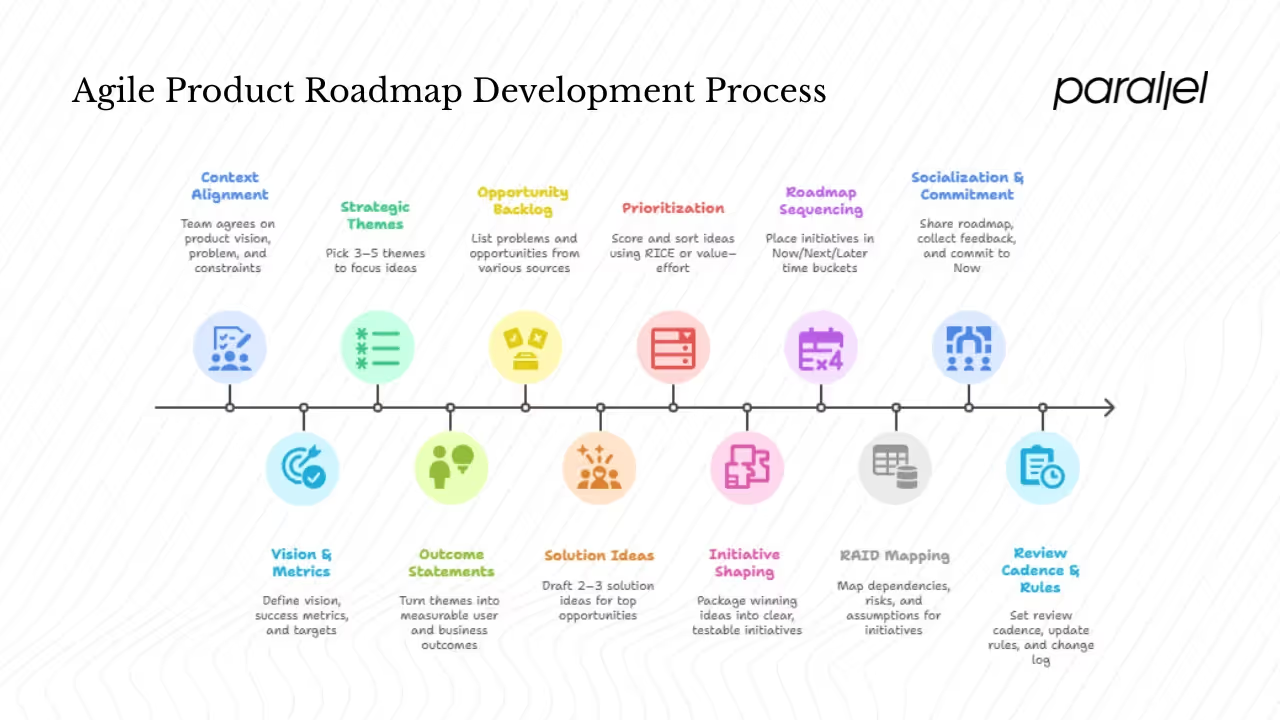
Step 1) Get on the same page about context
Goal: make sure everyone knows why you’re building this product and what constraints you’re under.
- Problem we’re solving (1–2 lines)
- Who it’s for and the core use cases
- Guardrails: budget, team capacity, deadlines, compliance, platform limits
- Time horizon: next 3–6–12 months
Output: a one-pager you can point to in later debates.
Step 2) Write a crisp vision and success metrics
Goal: set the north star and how you’ll track progress.
- Vision (single sentence)
- 2–4 outcome metrics (e.g., activation rate, retention at 8 weeks, gross margin)
- Targets for the next horizon (e.g., “Activation to 35% by Q2”)
Output: vision + measurable outcomes that tie every choice back to results.
Step 3) Pick 3–5 strategic themes
Goal: create focus so ideas don’t sprawl.
- Examples: “New user activation,” “Trust & quality,” “Expansion revenue,” “Platform foundations”
- For each theme, add a short intent line and 1–2 guiding principles (what you will and won’t do)
Output: a short list of themes that acts as a filter for ideas.
Step 4) Turn themes into outcome statements
Goal: define what success looks like in user and business terms.
- “Increase week-4 retention from 20% to 30% by improving first-week value”
- “Cut onboarding time from 20 minutes to 8 minutes without hurting accuracy”
Output: 3–8 outcome statements, each tied to one theme.
Step 5) Build an opportunity backlog (not features yet)
Goal: list the problems and opportunities that could move those outcomes.
Sources:
- User interviews, support tickets, reviews
- Product analytics (funnels, cohorts, feature usage)
- Competitor moves and market data
- Technical constraints and enablers
- Sales and success teams’ top asks
Write each opportunity like this:
- Opportunity: “Users drop at step 3 of signup”
- Evidence: “62% drop rate; 18 sessions reviewed”
- Impact if solved: “+8–12% activation”
Output: a problem-first backlog.
Step 6) Draft solution ideas for the top opportunities
Goal: explore multiple ways to solve each problem without locking in.
For each top opportunity, list 2–3 solution ideas with a sentence on how it would work and what you’d measure.
Output: 10–20 lightweight ideas tied to problems.
Step 7) Score and sort with a simple method (RICE or value–effort)
Goal: pick the few that matter most right now.
RICE quick refresher
- Reach: users/transactions affected in a period
- Impact: effect on the target metric (e.g., 0.25 low, 0.5 medium, 1 high, 2 massive)
- Confidence: 0–100%
- Effort: person-months (engineering + design + PM + data)
RICE score = (Reach × Impact × Confidence) ÷ Effort
Example:
If you prefer dead-simple, use a value–effort grid and pick high-value, low-effort first.
Output: a ranked list you can defend.
Step 8) Shape initiatives (outcomes → bets → measurable slices)
Goal: package winning ideas into clear, testable bets.
For each initiative:
- Outcome targeted: which metric and how much movement
- Scope v1: the smallest slice that proves value
- Measures: what you’ll track and when
- Owner: single DRI
- Rough effort: S/M/L or person-months
Output: 5–12 named initiatives with owners and expected impact.
Step 9) Place initiatives in time buckets: Now / Next / Later
Goal: create a roadmap that guides sequencing without over-promising dates.
Add milestones or external dates where real. Avoid fake deadlines.
Output: a one-page Now/Next/Later view.
Step 10) Map dependencies, risks, and assumptions
Goal: surface blockers before they bite.
- Dependencies: teams, components, integrations, vendors
- Risks: product, tech, legal, market
- Assumptions: what must be true for the bet to pay off
- Mitigations/experiments: how you’ll reduce risk or prove the assumption
Simple matrix:
Output: a compact RAID-style list tied to initiatives.
Step 11) Socialize, collect feedback, and commit the Now bucket
Goal: stress-test the plan and lock the short-term slice.
- Share the one-pager + Now/Next/Later + ranked list
- Ask: “What’s missing?”, “Where’s the biggest risk?”, “What would you cut?”
- Adjust based on real risks or stronger evidence
- Commit the Now initiatives with owners and expected outcomes
Output: a shared plan the team believes in.
Step 12) Set the review cadence and update rules
Goal: keep the roadmap alive.
- Cadence: monthly for early teams; quarterly once stable
- Inputs: latest metrics, learnings, support insights, sales intel, tech health
- Rules: what triggers moves between Now/Next/Later; how to add or drop items
- Change log: tiny dated entries so people see what changed and why
Output: a repeatable loop that keeps the roadmap useful.
Types and formats of agile product roadmaps
Agile product roadmaps can take different shapes depending on how a team plans, tracks, and communicates its work. Each format serves a slightly different purpose, and the best choice often depends on how predictable your timelines are and how your team prefers to visualize progress.
1. Time-Based Roadmaps
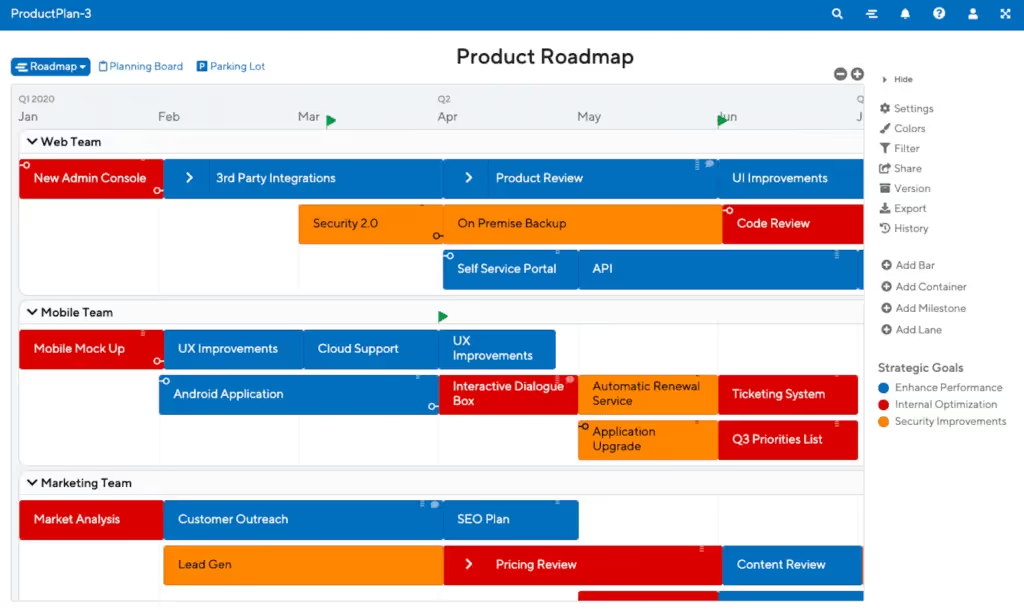
Time-based roadmaps organize initiatives by specific periods—such as months, quarters, or sprints. They’re helpful when a team needs to align product plans with broader business cycles, marketing campaigns, or financial planning. This format provides a clear sense of timing and helps stakeholders understand when major milestones are expected. However, rigid timelines can be tricky in fast-moving environments where priorities shift quickly.
2. Theme- or Goal-Oriented Roadmaps
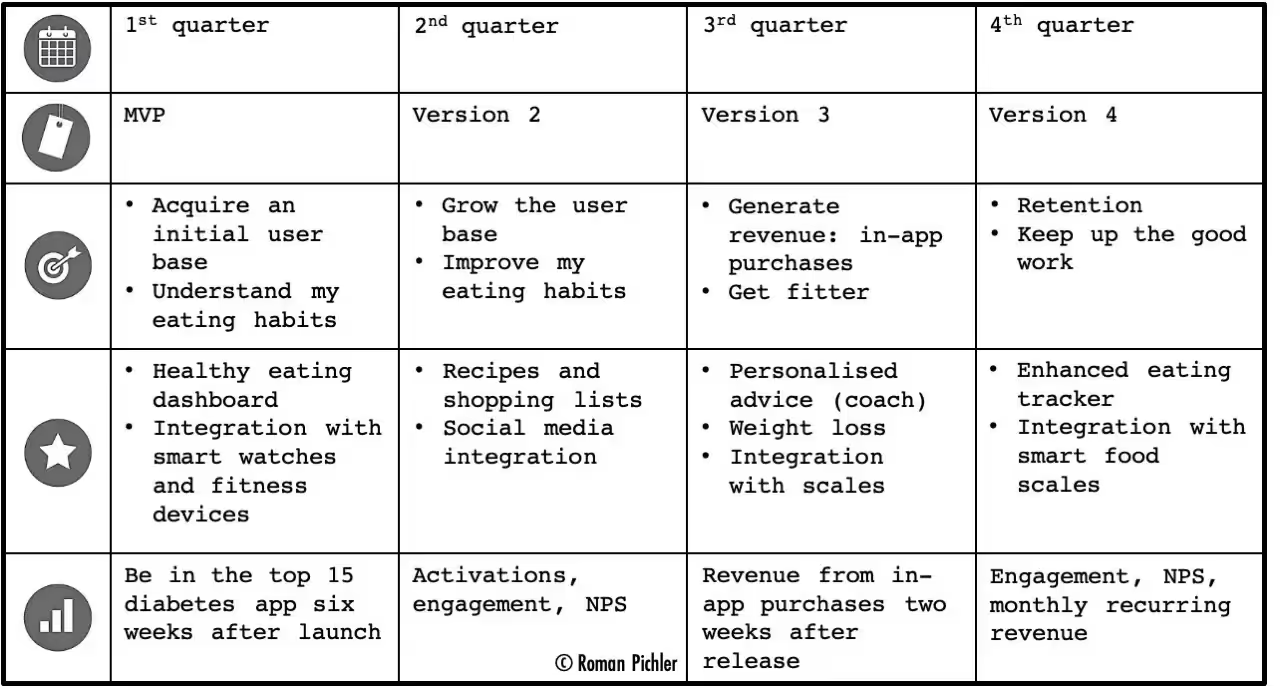
When exact dates are uncertain, teams often use a theme- or goal-based structure. Instead of focusing on “when” something will happen, this approach groups work around strategic objectives—like improving user retention, reducing churn, or expanding into a new market. It ties initiatives to outcomes that matter to the business and allows teams to adapt timelines without losing sight of purpose.
3. Outcome-Centric Roadmaps
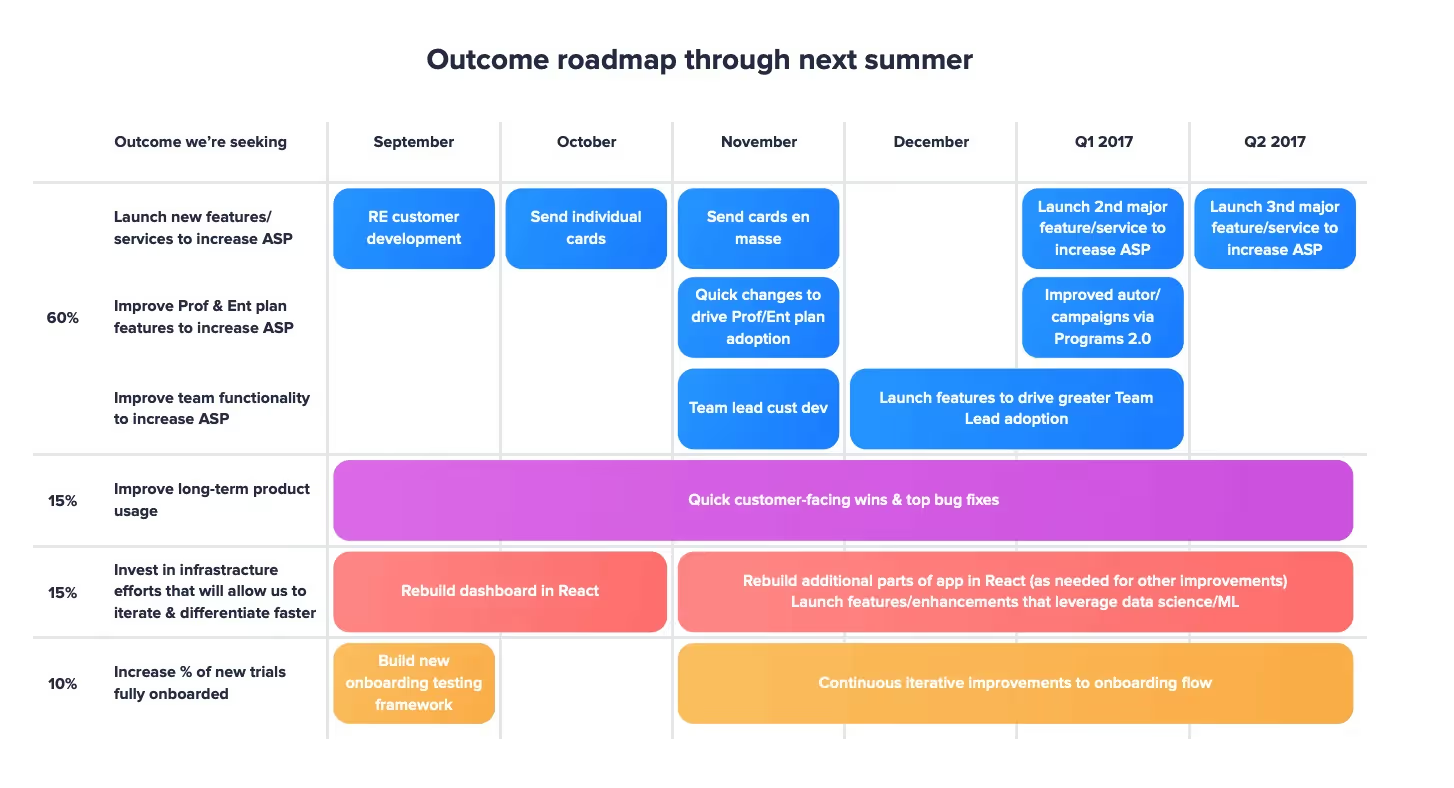
Outcome-centric roadmaps push the idea even further by focusing on measurable impact rather than specific features or deliverables. The emphasis is on results such as “increase daily active users by 10%” or “cut onboarding time in half.” This helps teams shift the conversation from output (what’s being built) to outcome (why it matters and how success will be measured). It’s a strong fit for organizations that prioritize experimentation and continuous improvement.
4. Hybrid or Mixed Approaches
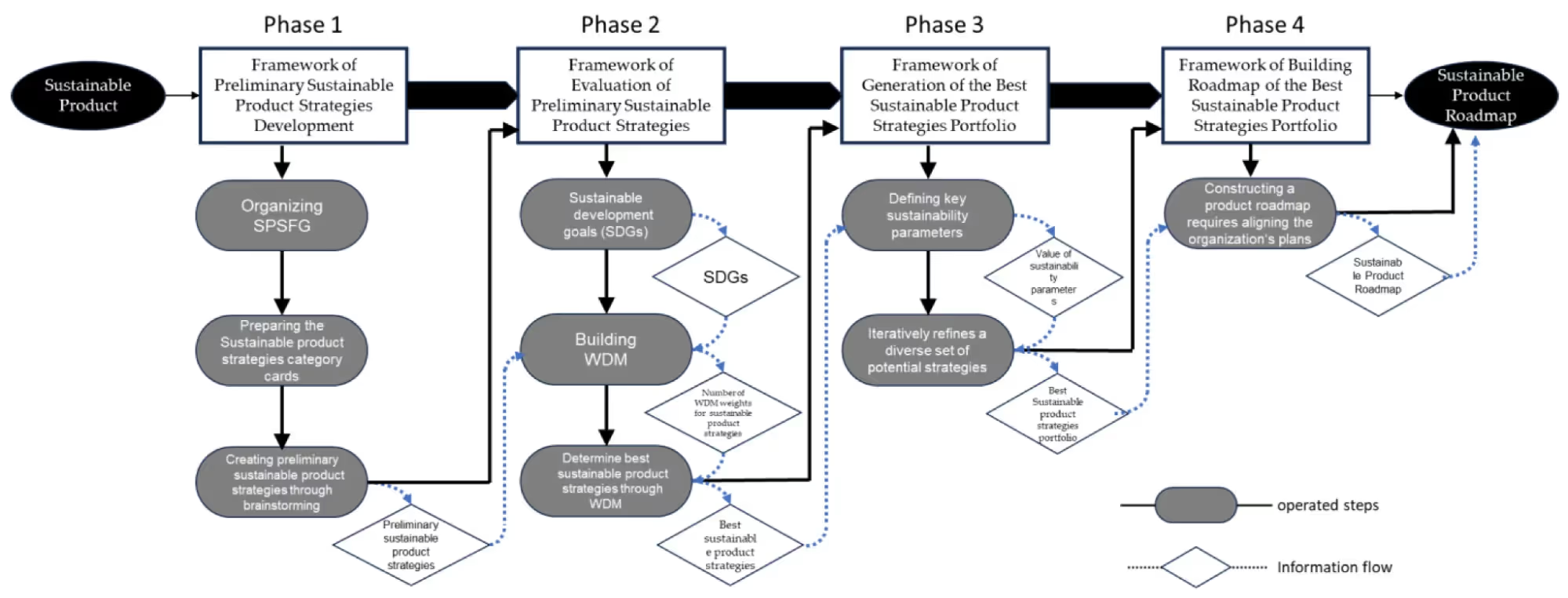
Many teams blend these styles to balance clarity and flexibility. A common hybrid model uses thematic groupings with time horizons layered on top—such as “now,” “next,” and “later.” This keeps short-term work visible while allowing long-term plans to stay fluid. Another option is to use strategic themes as swimlanes, with initiatives plotted along a loose timeline underneath.
Formats and Tools:
The visual layout of a roadmap matters almost as much as its structure. Some teams prefer Kanban boards to represent a continuous flow of work. Others use swimlane charts to separate streams like customer experience, infrastructure, and growth. Simple tables or spreadsheets work well for smaller teams that value transparency over polish. Whatever format you choose, the key is to keep it updated as priorities change. An outdated roadmap quickly loses its value.
Best practices and pitfalls for early‑stage or lean contexts
Early‑stage startups have unique constraints: small teams, limited runway and many unknowns. These tips help keep your roadmap useful rather than burdensome.
1) Keep it lightweight
Avoid over‑engineering your roadmap. You don’t need fancy charts to get value. A simple table or timeline can communicate vision and priorities. Focus on clarity rather than aesthetics.
2) Be conservative with commitments
Don’t promise exact dates unless you must. Stakeholders will hold you to them. Instead, use time buckets and state assumptions. Over‑committing erodes trust when plans change.
3) Use guardrails, not contracts
An agile roadmap is guidance, not a binding agreement. Label uncertain items as “tentative” or “exploratory bets.” This sets expectations that plans may shift as you learn. Tempo’s guide reminds us that agile roadmaps facilitate change while controlling scope creep.
4) Get stakeholders on the same page early and often
Early‑stage startups need a lightweight approach. Keep your roadmap simple and avoid over‑engineering it. Use coarse time buckets instead of committing to exact dates unless necessary. Provide guidance, not contracts—mark speculative ideas as exploratory bets. Bring stakeholders into roadmap reviews and listen to feedback so everyone stays on the same page. Explain the “why” behind each item and use personas, user research or metrics to justify decisions. Constantly collect user feedback through interviews, support tickets and analytics, and reassess priorities when new insights come up. Track progress against your assumptions; if a feature takes longer than expected or doesn’t move the needle, adjust what comes next. Maintain two planning horizons: a broad view for the next six to twelve months and a more detailed view for the next few sprints to avoid listing everything at once.
Using the roadmap in agile workflows
A roadmap isn’t a static document. It feeds into day‑to‑day agile practices and changes as you deliver and learn. To put what is a product roadmap in agile into practice, use your plan to guide backlog refinement and sprint planning: break initiatives into user stories and choose tasks that advance your goals. When more than one team is involved, share a single roadmap and sync regularly so that dependencies are surfaced and no one blocks another. Adjust the amount of detail for each audience: executives and investors care about strategic themes and business impact, designers and engineers need more specifics, and sales and marketing want to know when features will ship. Track progress with visual indicators and tie each initiative to a measurable outcome such as onboarding completion rate or revenue contribution. As retrospectives, customer feedback or metrics reveal new information, move, drop or accelerate initiatives. Agile roadmaps work when they adapt quickly to evidence.
Case study: an early‑stage marketplace app
Picture a pre‑seed marketplace that connects artisans with shoppers. The vision is to empower sellers and make unique goods accessible. To build your roadmap, organise work into themes such as onboarding, trust & safety and discovery. Under each theme, group initiatives into Now/Next/Later buckets: maybe launch a self‑service listing flow and payment processing now, add a rating system and curated feed next, and tackle advanced search and recommendations later. Flag dependencies, such as the need for a third‑party payment provider before escrow can go live. After launch, user research might reveal that sellers need help taking good photos, prompting you to shift a photography‑guidance initiative forward. During backlog refinement, break each initiative into stories and schedule them into sprints. This lean roadmap gives investors and teammates clarity without locking the team into a rigid plan.
When an agile product roadmap doesn’t work and alternatives
Despite its benefits, a roadmap can become a burden if used incorrectly. Signs include constantly missed dates, rigid adherence to a plan despite new evidence, and lack of stakeholder engagement. In such cases, consider alternatives.
If your team is struggling to grasp what is a product roadmap in agile, or if the artifact no longer serves its purpose, these alternative approaches may offer a better fit.
- Rolling‑wave planning: Instead of a full roadmap, plan in waves. Define broad goals for the next quarter and keep the rest vague. As you complete a wave, plan the next. This works when uncertainty is high.
- Lean canvas or product canvas: Early in product discovery, a lean canvas captures assumptions about customer segments, value propositions and channels. It’s a good starting point before you have enough insight for a roadmap.
- Continuous discovery model: Teams with strong discovery practices may forego a traditional roadmap. They maintain a prioritized opportunity backlog and constantly test solutions. This approach fits when you’re iterating on early product‑market fit.
If your roadmap feels like a straightjacket, step back and ask whether you need to simplify or switch methods. The tool should serve you, not the other way around. Knowing what is a product roadmap in agile will help you decide when to use one or pivot to another model.
Conclusion
In this article we’ve explored what is a product roadmap in agile from theory to practice. A product roadmap in agile is a guardrail, not a straightjacket. It provides direction and context while allowing for change. Without it, teams risk chasing random requests and losing sight of the mission. With it, you can show how short‑term work leads to long‑term outcomes. What matters is keeping it lightweight, grounded in vision and strategy, open to feedback and updated. Don’t build a roadmap because you “should”; build it because it helps your team think, discuss and decide.
So what’s next? Take a blank canvas and sketch your first agile roadmap. Start simple. Identify your themes, list your initiatives, and place them into now/next/later buckets. Involve your team and stakeholders early. Then use it as a living conversation piece. That’s how you answer what is a product roadmap in agile for your context and turn intention into progress.
Your first roadmap may be messy, but it’s the beginning of a valuable conversation.
FAQ
1) What is an agile product roadmap?
It’s a strategic, big‑picture plan that shows how a product may change over time while embracing agility. It ties product vision to execution and leaves room to adjust as new information emerges.
2) Who creates a product roadmap in agile?
The product manager or product owner usually leads, but it should be a collaborative effort. Effective roadmaps gather input from engineering, design, leadership and stakeholders.
3) What are the three components of a product roadmap?
A common structure includes vision or themes, initiatives (epics or features), and time horizons or milestones. Additional layers such as dependencies, metrics and assumptions may support these parts.
4) What is the point of a product roadmap?
It’s meant to get stakeholders on the same page about vision and priorities, give context to day‑to‑day work, manage expectations about timing and change, and support proactive planning.







.avif)





